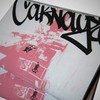WANTO, painting a fill-in. All photos by the author
To understand Asia's graffiti scene you have to go to Tokyo, the region's graff mecca and a source of so much of the styles you see in the alleyways and walls of Hong Kong, Taipei, and Seoul. The most important crew in Tokyo graffiti is called 246—it boasts members from Japan, the US, Mexico, and Taiwan, including MQ, SODUH, PEAR, RESQ, SAYM, YU, and ZOMBRA—and arguably the most important man in the scene is 246's founder, WANTO.
Advertisement
WANTO is known for his spiky "W" and characteristic tag that's equally effective vertically and horizontally. His style is a product of the mid 90s, when, inspired by American writers, WANTO turned from painting colorful pieces to bombing with tags and throw-ups.In 2004, the Tokyo native traveled across the US with one-time writing partner, SECT, and became associated with the prominent US graffiti crew MSK. (The duo's exploits are chronicled in the book Who am I. Where am I.) NOE, a 246 member I spoke to in Taiwan, told me that WANTO wanted to be more than just an Asian offshoot of MSK, so he started his own crew, 246, in 2008, named after a major traffic artery in Tokyo. The group soon included other graffiti writers with similar aesthetics and boundless ambitions, writers with bold, readable throw-ups who were already considered to be among the most active in their respective cities.
WANTO tagging
I met WANTO in a local Tokyo neighborhood izakaya one night in hopes of catching up on the current state of Tokyo graffiti. He was calm, confident, a bit mischievous, and very humble—not wanting to speak for all of the Tokyo graffiti scene on the record, he declined to be quoted for this article. Instead, he suggested that I accompany him on a nighttime bombing run.
WANTO in action
It had been raining heavily all afternoon and Tokyo's ubiquitous see-through plastic umbrellas dotted the streets. A wet evening might not be ideal for sightseeing, but it was perfect for our purposes. The streets were largely empty, and any unsuspecting pedestrians and drivers were likely to be preoccupied with the rain. WANTO used his umbrella to cover his movements as he finished a double throw-up on a shutter at a busy intersection and crouched on corners to catch tags.
Advertisement
After we had zig-zagged our way through dark streets and along a local train line toward Shibuya, we eventually reached the crew's namesake street, Route 246. Tags and throw-ups by the crew's far-flung members lined almost every block, some hidden and faded, others screaming for attention with bold, high-contrast letters on well-lit walls and shutters. WANTO moved along the road with swiftness and determination, hitting spots with markers and spray paint. Eventually he abandoned his umbrella for the sake of greater mobility, and, under the advancing cover of night, didn't stop bombing until all of his cans were empty.
WANTO doing a throw-up
I retraced our steps the next day, the rain having cleared up. Tokyo is a graffiti connoisseur's dream, The city's walls, doorways, and shutters were like the world's biggest guest book. Practically every writer of note in Asia has visited Tokyo at one time or another, and some spots were covered in the names of American writers. On my trip through Asia, I had been trailing UFO—a New York writer who founded the notorious 907 crew—in several cities by just a few weeks. He had been in Tokyo for an art show just before I arrived, and I found his distinctive alien character wherever I turned. The wholly anonymous KUMA and street-vandal-turned-gallery-sensation NECKFACE still had a famous ledge spot in Shibuya that remained unscathed, while the bi-coastal American bombing legend MQ also seemed to maintain a constant presence.
Advertisement
BLAKE, YK, RESQ, WANTO, and MQ
But the streets were dominated by the locals. Graffiti by WANTO's 246 crew-mates TOM and RUST, as well as Japanese writers like HENKA, DART, MINT, and SECT, was everywhere in sight. A flurry of writers from nearby Osaka with their distinctive (albeit almost illegible) flared throw-ups were also covering the city's graff hot spots with paint. Ultimately it was the Japanese vandals, not Tokyo's international visitors, whose presence dominated—the locals are the ones who put the city on the map, and they're the ones who will keep it there.See more photos from Ray's Tokyo trip below.Ray Mock is the founder of Carnage NYC and has been documenting graffiti in New York and around the world for ten years, publishing more than two dozen limited edition zines and books. Follow him on Instagram.
RUST, TOM, MQ, ZOMBRA, HYPE
UFO 907
YU
WANTO, TOM
WANTO tagging a trashcan
KUMA, NECKFACE
Harajuku
Shinjuku
